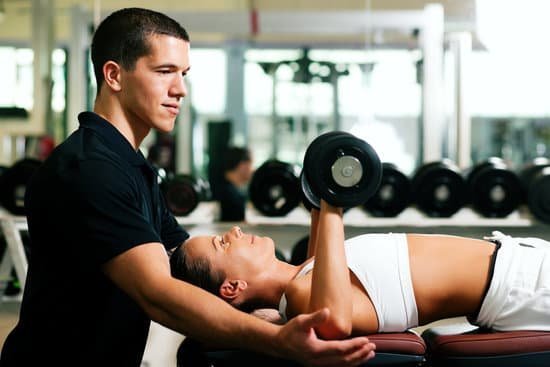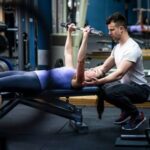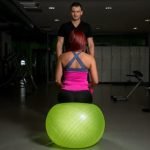Powerbuilding fitness workouts combine the strength-focused principles of powerlifting with the muscle-building focus of bodybuilding. In essence, powerbuilding aims to increase both strength and muscle mass simultaneously, making it a versatile training approach for individuals looking to achieve overall physical development.
Unlike traditional powerlifting, which primarily focuses on performance in three main lifts (squat, bench press, deadlift), or bodybuilding, which emphasizes building muscle size and aesthetics, powerbuilding strikes a balance between the two disciplines. This hybrid approach allows individuals to not only lift heavy weights but also sculpt their physique through targeted exercises and strategic programming.
The science behind powerbuilding workouts lies in the concept of progressive overload – gradually increasing the weight or intensity of your exercise routine to continually challenge your muscles and stimulate growth. By incorporating elements of both strength training and hypertrophy-focused exercises into a structured workout plan, powerbuilders can maximize their gains in strength, size, and overall fitness level. Stay tuned as we delve deeper into the benefits, key components, and strategies of powerbuilding fitness workouts in this article.
The Difference Between Powerlifting, Bodybuilding, and Powerbuilding
Powerlifting, bodybuilding, and powerbuilding are all popular fitness approaches that have unique goals and methodologies. Understanding the key differences between these three disciplines is essential for individuals looking to tailor their workout routines to meet specific fitness objectives.
Powerlifting focuses on three main compound lifts: squat, bench press, and deadlift. The primary goal of powerlifters is to lift as much weight as possible in these specific movements, with competitions based on the total weight lifted across these three exercises. Powerlifting workouts typically involve low repetitions with extremely heavy weights, aimed at building strength and improving performance in these lifts.
On the other hand, bodybuilding places a greater emphasis on aesthetics and muscle size. Bodybuilders aim to sculpt their physique by targeting individual muscle groups with higher repetitions and moderate weights. The goal is to achieve symmetrical muscle development and definition, often focusing on creating a visually pleasing physique for competitions or personal satisfaction.
Now, where does powerbuilding fit into this spectrum? Powerbuilding combines elements of both powerlifting and bodybuilding to create a balanced approach that focuses on building strength while also increasing muscle mass. Powerbuilders incorporate heavy compound lifts like those in powerlifting to improve strength levels, but they also include accessory exercises commonly found in bodybuilding routines to enhance hypertrophy (muscle growth). This hybrid approach allows individuals to benefit from both strength gains and muscle size development simultaneously.
| Aspect | Difference |
|---|---|
| Main Focus | Strength and performance in specific lifts for powerlifting; Aesthetics and muscle size for bodybuilding; Strength gains and muscle growth for powerbuilding |
| Repetitions | Low repetitions with heavy weights for powerlifting; Higher repetitions with moderate weights for bodybuilding; Combination of low-rep strength work and hypertrophy-focused exercises for powerbuilding |
| Main Lifts | Squat, bench press, deadlift for powerlifting; Varied exercises targeting individual muscle groups for bodybuilding; Combination of compound lifts and accessory exercises for powerbuilding |
The Science Behind Powerbuilding Workouts
Powerbuilding workouts combine the principles of both powerlifting and bodybuilding to create a unique and effective training regimen that focuses on building strength and muscle mass simultaneously. In order to understand the science behind powerbuilding workouts, it is important to delve into the physiological adaptations that occur in the body during this type of training.
Progressive Overload
One of the key principles of powerbuilding workouts is progressive overload, which involves gradually increasing the weight or resistance used in exercises over time. This constant challenge placed on the muscles is what stimulates muscle growth and strength gains. By progressively overloading the muscles, individuals can push their bodies beyond their current limits, leading to hypertrophy (muscle growth) and increased strength.
Metabolic Adaptations
Powerbuilding workouts also elicit metabolic adaptations in the body due to the high-intensity nature of the training. When lifting heavy weights and performing compound movements, such as squats and deadlifts, the body requires a substantial amount of energy. This can lead to an increase in metabolic rate both during exercise and at rest, ultimately aiding in fat loss and improving overall body composition.
Hormonal Response
Another aspect of the science behind powerbuilding workouts is the hormonal response they trigger in the body. Heavy resistance training has been shown to increase levels of testosterone and growth hormone, both of which play crucial roles in muscle growth, repair, and recovery. By incorporating compound exercises with heavy loads into a workout routine, individuals can optimize their hormonal environment for maximum muscle-building potential.
Benefits of Powerbuilding Fitness Workouts
Powerbuilding fitness workouts offer a unique blend of strength training and muscle building, making them an excellent choice for individuals looking to maximize their physical performance. By combining elements of powerlifting and bodybuilding, powerbuilding routines focus on increasing both strength and muscle mass simultaneously. This approach provides a well-rounded fitness regimen that can lead to significant improvements in overall athletic performance.
Some key benefits of incorporating powerbuilding workouts into your fitness routine include:
- Enhanced Strength: Powerbuilding workouts emphasize compound exercises like squats, deadlifts, and bench presses, which target multiple muscle groups simultaneously. This can lead to substantial gains in overall strength.
- Increased Muscle Mass: By including hypertrophy-focused sets and rep ranges in addition to heavy lifting, powerbuilding workouts can help individuals build lean muscle mass effectively.
- Improved Athletic Performance: The combination of strength training and muscle building in powerbuilding workouts can translate to enhanced performance in sports or other physical activities.
Furthermore, the versatility of powerbuilding routines allows individuals to tailor their workout plans to their specific goals, whether they aim to compete in powerlifting competitions or simply improve their overall fitness levels. This adaptability makes powerbuilding an attractive option for individuals seeking a comprehensive approach to fitness that prioritizes both strength and aesthetics.
Overall, what sets powerbuilding apart is its ability to provide a holistic approach to physical fitness by combining the best elements of powerlifting and bodybuilding. If you are looking for a challenging yet rewarding workout regimen that focuses on both strength gains and muscle growth, incorporating powerbuilding routines into your fitness routine may be the perfect fit for you.
Key Components of a Powerbuilding Workout Routine
One of the key components of a powerbuilding workout routine is incorporating both strength-training and hypertrophy-focused exercises. This blend allows individuals to build both muscle mass and strength simultaneously, which sets powerbuilding apart from traditional bodybuilding or powerlifting routines. By combining heavy compound lifts like squats, deadlifts, and bench presses with higher-rep isolation exercises targeting specific muscle groups, powerbuilders can achieve a balanced physique that is both strong and aesthetically pleasing.
Another essential element of a powerbuilding workout routine is progressive overload. This principle involves gradually increasing the weight lifted or the volume of training to continually challenge the muscles and stimulate growth. Utilizing techniques such as pyramid sets, drop sets, or rest-pause sets can help keep workouts intense and effectively promote muscle adaptation. Additionally, tracking progress through a training log or app can help individuals monitor their strength gains and ensure they are consistently pushing their limits.
Incorporating adequate rest and recovery into a powerbuilding routine is crucial for optimal results. Muscle growth occurs during periods of rest, so ensuring that muscles have time to repair and rebuild between training sessions is essential for progress.
In addition to getting enough sleep each night, including active recovery days with activities like yoga or light cardio can help prevent injury and improve overall performance in the gym. Proper nutrition, hydration, and supplementation are also key components to support muscle recovery and growth in a powerbuilding fitness regimen.
| Key Components | Data |
|---|---|
| Strength-training and Hypertrophy Exercises | Blend for muscle mass and strength |
| Progressive Overload | Increase weight/volume for muscle growth |
| Rest and Recovery | Allow muscles to repair and grow |
Sample Powerbuilding Workout Plan for Beginners
Powerbuilding fitness workouts combine the strength-building aspects of powerlifting with the muscle-building focus of bodybuilding. This hybrid approach allows individuals to achieve both increased strength and muscle mass simultaneously, making it a popular choice for those looking to build a balanced physique. By incorporating elements from both powerlifting and bodybuilding, powerbuilding workouts provide a well-rounded fitness routine that targets various muscle groups while also improving overall strength.
When starting a powerbuilding workout plan as a beginner, it is essential to establish a solid foundation before progressing to more advanced techniques. Here is a sample powerbuilding workout plan for beginners to help kickstart your fitness journey:
- Day 1: Upper Body – Bench Press, Bent-Over Rows, Overhead Press, Bicep Curls
- Day 2: Lower Body – Squats, Deadlifts, Leg Press, Calf Raises
- Day 3: Rest Day or Active Recovery (light cardio or stretching)
- Day 4: Upper Body – Incline Bench Press, Pull-Ups, Shoulder Press, Tricep Extensions
- Day 5: Lower Body – Romanian Deadlifts, Lunges, Leg Curls, Planks
- Day 6: Rest Day or Active Recovery (yoga or mobility work)
- Day 7: Rest Day
This sample workout plan includes a mix of compound movements and isolation exercises to target different muscle groups effectively. It is important to progressively overload your muscles by increasing weight or reps as you get stronger.
Additionally, proper form and technique should always be prioritized to prevent injury and maximize gains in strength and muscle mass. As you advance in your powerbuilding journey, you can incorporate advanced techniques such as drop sets, supersets, or rest-pause sets to keep challenging your body and continue seeing progress.
Advanced Techniques and Strategies for Powerbuilding
Once you have established a strong foundation in your powerbuilding fitness routine, incorporating advanced techniques can take your workouts to the next level. One effective strategy is implementing periodization, which involves varying intensity and volume throughout different phases of your training.
This helps prevent plateaus and ensures continual progress in strength and muscle gains. By cycling through periods of higher volume and lower intensity, followed by phases of lower volume and higher intensity, you can challenge your muscles in new ways and stimulate further growth.
Another key technique for advancing in powerbuilding is incorporating supersets and drop sets into your workouts. Supersets involve performing two exercises back-to-back with minimal rest in between, targeting the same muscle group or opposing muscle groups. This not only increases the intensity of your workout but also helps save time by working multiple muscle groups simultaneously.
Drop sets, on the other hand, involve performing an exercise to failure, then immediately reducing the weight and continuing with more repetitions until failure again. This technique pushes your muscles to their limits, promoting muscle hypertrophy and endurance.
Furthermore, integrating progressive overload into your powerbuilding routine is crucial for continued gains in strength and muscle size. This method involves gradually increasing the weight lifted or the number of reps performed over time to continually challenge your muscles.
By consistently pushing yourself beyond your comfort zone, you can stimulate further adaptations in muscle fibers, leading to increased strength and muscle mass. Remember to track your progress diligently to ensure that you are progressively overloading your muscles effectively for optimal results.
Common Mistakes to Avoid in Powerbuilding Workouts
When embarking on a powerbuilding fitness journey, it is essential to be aware of common mistakes that can hinder progress and potentially lead to injury. By avoiding these pitfalls, individuals can maximize the effectiveness of their workouts and achieve their desired results. Here are some key mistakes to steer clear of in powerbuilding workouts:
Ignoring Proper Form
One of the most crucial aspects of any strength training regimen, including powerbuilding workouts, is maintaining correct form throughout exercises. Neglecting proper form not only reduces the effectiveness of the workout but also increases the risk of injury. It is important to prioritize technique over lifting heavy weights to ensure long-term success in powerbuilding.
Overtraining Without Adequate Recovery
Many beginners in powerbuilding may fall into the trap of overtraining in their eagerness to see rapid progress. However, overtraining without allowing sufficient time for recovery can lead to burnout, decreased performance, and increased risk of injury. It is crucial to incorporate rest days into your workout schedule and prioritize adequate sleep and nutrition for optimal recovery.
Neglecting Balanced Programming
Another common mistake in powerbuilding workouts is focusing too heavily on certain muscle groups while neglecting others. For a well-rounded physique and balanced strength development, it is essential to follow a comprehensive training program that targets all major muscle groups equally. Incorporating exercises for multiple muscle groups ensures overall strength gains and reduces the likelihood of muscular imbalances or weaknesses.
By being mindful of these common mistakes and implementing strategies to avoid them, individuals can optimize their powerbuilding fitness journey and make significant progress towards their goals. Remember that consistency, proper form, adequate recovery, and balanced programming are key principles for success in powerbuilding workouts.
Nutrition and Diet Tips for Powerbuilding Fitness Goals
When it comes to achieving your fitness goals through powerbuilding workouts, it’s essential to pay attention to your nutrition and diet. Regardless of how intense your workout routine is, without the proper fuel, your body won’t be able to perform at its best or recover effectively. In order to maximize the benefits of your powerbuilding regimen, it’s crucial to fuel your body with the right nutrients.
One key aspect of nutrition for powerbuilding is ensuring an adequate intake of protein. Protein plays a crucial role in muscle repair and growth, making it essential for anyone looking to build strength and size. Aim to consume a variety of high-quality protein sources such as lean meats, poultry, fish, eggs, dairy products, and plant-based proteins like beans and legumes.
In addition to protein, carbohydrates are another important component of a powerbuilding diet. Carbs provide energy for intense workouts and help replenish glycogen stores in muscles post-exercise. Focus on incorporating complex carbs like whole grains, fruits, vegetables, and legumes into your meals to support your training sessions and promote recovery.
Don’t forget about healthy fats either – they play a role in hormone production and overall health. Prioritize sources like avocados, nuts, seeds, olive oil, and fatty fish in moderation for optimal performance during your powerbuilding workouts.
Conclusion
In conclusion, powerbuilding fitness workouts offer a unique blend of strength training and muscle building that can benefit individuals looking to improve their overall athleticism and physique. Unlike traditional powerlifting or bodybuilding routines, powerbuilding combines the best of both worlds to create a balanced and effective workout regimen.
One of the key advantages of powerbuilding workouts is their ability to promote functional strength while also enhancing muscle size and definition. By incorporating compound movements like squats, deadlifts, bench presses, and rows, individuals can target multiple muscle groups in each session, leading to efficient and effective results. This dual focus on strength and hypertrophy sets powerbuilding apart from other fitness approaches.
Additionally, the science behind powerbuilding workouts supports their effectiveness in stimulating muscle growth and increasing overall strength levels. By incorporating progressive overload principles, periodization techniques, and strategic exercise selection, individuals can continually challenge their bodies to adapt and grow stronger over time.
With proper nutrition and recovery strategies in place, those who commit to a consistent powerbuilding routine can achieve significant gains in both muscle mass and strength. Consider giving powerbuilding workouts a try if you are looking for a well-rounded fitness program that delivers results in terms of both aesthetics and performance.
Frequently Asked Questions
What Is a Power Builder in Fitness?
A power builder in fitness is someone who focuses on building strength and muscle mass simultaneously. This approach typically involves a combination of heavy, compound lifts like squats, deadlifts, and bench press, along with hypertrophy-focused exercises to maximize muscle growth.
What Is the Best Powerbuilding Program?
The best powerbuilding program is subjective and depends on individual goals, preferences, and experience level. However, programs like 5/3/1 by Jim Wendler, Westside Barbell, or the P.H.A.T (Power Hypertrophy Adaptive Training) program are popular choices among powerbuilders due to their focus on both strength and muscle gains.
What Is the Difference Between Powerlifting and Powerbuilding?
The main difference between powerlifting and powerbuilding lies in their primary goals and training methods. Powerlifting focuses solely on improving maximal strength in three main lifts: squat, bench press, and deadlift. On the other hand, powerbuilding combines elements of powerlifting with bodybuilding to increase strength while also emphasizing muscle hypertrophy across various muscle groups.

Passionate about providing useful information to anyone with an interest in the field of Personal Training, I strive to pass on to our readers quality information and to answer any questions about Personal Trainers, the work they do and how to become one.





